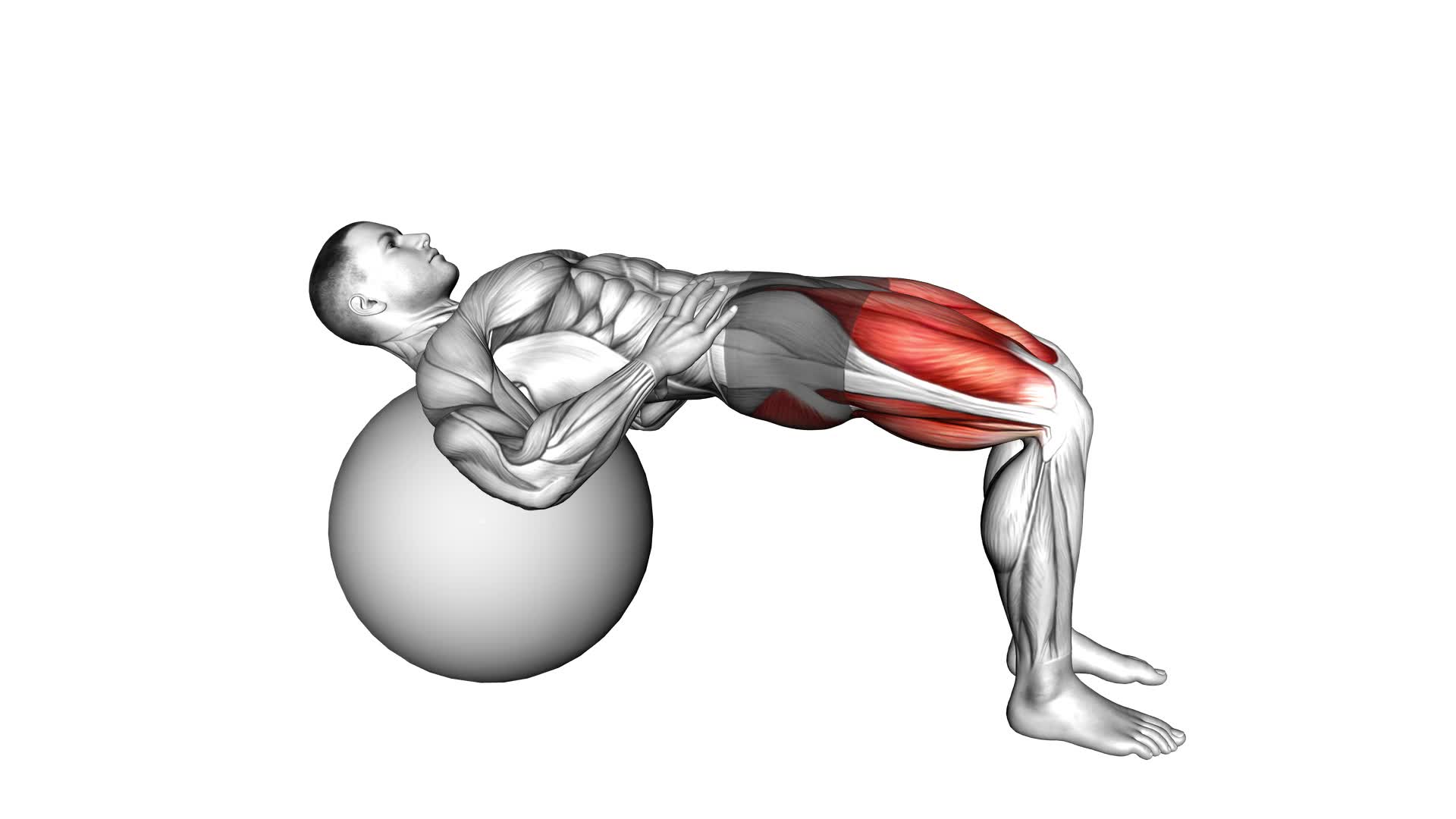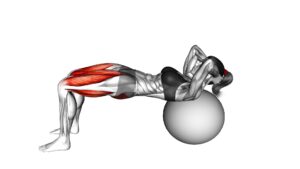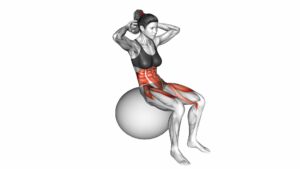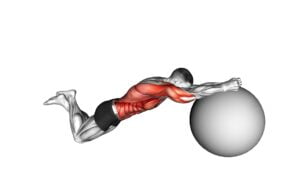Lying Hip Lift (On Stability Ball) (Male) – Video Exercise Guide & Tips

Looking to strengthen your core and glutes? The lying hip lift on a stability ball is the perfect exercise for you! This video exercise guide and tips will show you how to perform the move correctly, with proper form and technique.
Watch This Exercise Video
Whether you're a beginner or have limited mobility, modifications are available. Avoid common mistakes and maximize your results with these helpful tips.
Get ready to feel the burn and see amazing results with this challenging yet effective exercise!
Key Takeaways
- The lying hip lift exercise strengthens core muscles and increases glute activation.
- It improves hip flexibility and contributes to stability and balance.
- The exercise can enhance athletic performance.
- Advanced variations of the exercise include lifting one leg or adding a resistance band.
Benefits of the Lying Hip Lift
One benefit of the lying hip lift is that it can help you strengthen your core muscles. By performing this exercise, you activate your glutes, leading to increased glute activation. This is important because strong glute muscles not only enhance your athletic performance but also contribute to overall stability and balance.
Additionally, the lying hip lift promotes improved hip flexibility. As you lift your hips off the ground, you stretch your hip flexors, which can become tight due to prolonged sitting or a sedentary lifestyle. Increasing hip flexibility can alleviate lower back pain and improve your range of motion in daily activities or other exercises.
By incorporating the lying hip lift into your routine, you can target and strengthen your core muscles while also enhancing glute activation and hip flexibility. This exercise serves as a foundation for building a strong and functional body.
Now, let's move on to discuss the equipment needed for performing the lying hip lift.
Equipment Needed for the Exercise
To perform the lying hip lift, you'll need a stability ball. Here is the equipment needed for the exercise:
- Stability Ball: A stability ball, also known as an exercise ball or Swiss ball, is essential for performing the lying hip lift. Make sure to choose a ball that's the appropriate size for your height.
- Mat: Although not necessary, using a mat can provide additional comfort and support during the exercise.
- Dumbbells (Optional): For advanced variations of the lying hip lift, you may choose to add resistance by holding dumbbells.
- Resistance Band (Optional): Another option for adding resistance is using a resistance band. This can increase the intensity of the exercise and target different muscle groups.
- Ankle Weights (Optional): For those looking for an extra challenge, ankle weights can be worn to increase the difficulty of the exercise.
Now that you know the equipment needed for the lying hip lift, let's move on to the next section about proper form and technique.
Proper Form and Technique
To perform the lying hip lift with proper form and technique, focus on engaging your core and maintaining stability on the stability ball. This exercise targets your glutes, hamstrings, and lower back, so it's important to execute it correctly.
Start by lying on your back with your feet flat on the ground and the stability ball positioned under your heels. Place your arms by your sides, palms facing down. Take a deep breath in and as you exhale, engage your core muscles by pulling your belly button towards your spine.
Pressing your heels into the stability ball, lift your hips off the ground until your body forms a straight line from your knees to your shoulders. Keep your glutes and core engaged throughout the movement.
Inhale as you lower your hips back down to the starting position. Repeat for the desired number of repetitions.
Proper breathing techniques are essential during this exercise. Remember to exhale as you lift your hips and inhale as you lower them back down.
For advanced practitioners, there are variations you can try to increase the challenge. You can perform the exercise with one leg lifted off the ball, or you can add a resistance band around your thighs to provide additional resistance.
Remember to always listen to your body and stop if you experience any pain or discomfort.
Modifications for Beginners or Those With Limited Mobility
If you're a beginner or have limited mobility, there are modifications you can make to the lying hip lift exercise on a stability ball. Here are some options to consider:
- Perform the exercise on a mat: If using a stability ball is challenging, you can start by doing the lying hip lift on a mat. This provides a stable surface and reduces the need for balance.
- Use a smaller stability ball: Instead of using a standard-sized stability ball, you can opt for a smaller one. This can make the exercise more manageable and less demanding on your muscles.
- Limit the range of motion: If lifting your hips all the way up is difficult, you can modify the exercise by only lifting them partially. Start with a smaller range of motion and gradually increase it as you build strength and confidence.
- Place your feet wider apart: By widening your foot placement on the stability ball, you can enhance stability and reduce the difficulty of the exercise.
- Use a support or assistance: If you have limited mobility, you can place your hands on a sturdy object, such as a bench or chair, to provide support and help you maintain balance during the exercise.
These modifications allow beginners or individuals with limited mobility to still benefit from the lying hip lift exercise on a stability ball while adjusting the difficulty level to their capabilities. Remember to listen to your body and consult with a healthcare professional before starting any new exercise program.
Common Mistakes to Avoid
To avoid common mistakes during the lying hip lift exercise on a stability ball, it's important to focus on proper hip alignment and engaging your core muscles.
Ensure that your hips are aligned with your shoulders and knees to maintain stability and prevent strain on your lower back.
Additionally, engage your core by pulling your belly button in towards your spine throughout the movement to maximize the effectiveness of the exercise.
Proper Hip Alignment
Ensure proper hip alignment by engaging your core and maintaining a neutral spine during the lying hip lift exercise on the stability ball. Proper hip alignment is crucial for maximizing the benefits of this exercise and preventing injury. Here are some common mistakes to avoid:
- Avoid arching your lower back: Keep your lower back flat against the stability ball to maintain a neutral spine.
- Don't let your knees cave in: Keep your knees in line with your hips to engage the hip muscles effectively.
- Avoid excessive hip rotation: Keep your hips stable and avoid twisting or rotating them during the exercise.
- Don't overextend your hips: Lift your hips only until your body forms a straight line from your knees to your shoulders.
- Avoid using momentum: Focus on using your hip muscles to lift your hips, rather than relying on momentum.
Engaging Core Muscles
Maintain proper hip alignment by engaging your core muscles and avoiding common mistakes during the lying hip lift exercise on the stability ball.
Core activation is crucial for this exercise as it helps stabilize your spine and pelvis, preventing any unnecessary strain or injury. To engage your core, focus on pulling your belly button towards your spine and activating your deep abdominal muscles.
Avoid overarching your lower back, as this can put excessive pressure on your spine. Instead, keep your abs engaged and your lower back pressed into the stability ball.
Strengthening your abs through this exercise won't only improve your stability but also support your overall posture. Remember to breathe naturally throughout the movement and maintain control to maximize the effectiveness of the exercise.
Tips for Maximizing Your Results
Get the most out of your lying hip lift exercise on the stability ball by focusing on your form and engaging your core muscles. To maximize your results and increase workout intensity, follow these tips:
- Maintain proper form: Ensure that your back is flat against the stability ball and your feet are firmly planted on the ground. This will help target the right muscles and prevent unnecessary strain.
- Engage your core: Before lifting your hips, activate your core muscles by pulling your belly button towards your spine. This will help stabilize your body and increase the effectiveness of the exercise.
- Control the movement: Slowly lift your hips off the ground, engaging your glutes and hamstrings. Avoid using momentum and focus on using your muscles to perform the movement.
- Squeeze at the top: At the top of the movement, pause for a second and squeeze your glutes. This will further engage the muscles and promote muscle growth.
- Breathe properly: Inhale as you lower your hips and exhale as you lift them. Proper breathing technique will help you maintain control and increase the effectiveness of the exercise.
Frequently Asked Questions
How Many Reps and Sets Should I Do for the Lying Hip Lift Exercise?
To get the most out of the lying hip lift exercise, it's important to know how many reps and sets to do.
The recommended number of sets and reps for this exercise can vary depending on your fitness level and goals. However, a common guideline is to start with 2-3 sets of 10-15 reps.
This will help you build strength and endurance in your glutes and core. Remember to listen to your body and adjust the intensity as needed.
The lying hip lift exercise can help improve your hip stability and strengthen your lower body.
Can I Perform the Lying Hip Lift Exercise on a Regular Exercise Mat Instead of a Stability Ball?
Yes, you can perform the lying hip lift exercise on a regular exercise mat instead of a stability ball.
However, using a stability ball offers additional benefits. It provides an unstable surface, engaging more muscles for improved core stability and balance.
The ball also allows for a greater range of motion, enhancing the effectiveness of the exercise.
How Long Should I Hold the Top Position of the Lying Hip Lift Exercise?
To hold the top position of the lying hip lift exercise, aim for a duration that challenges your muscles without compromising form.
Beginners can start with a 5-10 second hold and gradually increase as they build strength.
Advanced users can try different variations, such as adding resistance bands or using a single leg lift to increase difficulty.
Remember to engage your core and squeeze your glutes throughout the exercise for maximum effectiveness.
Is It Normal to Feel Discomfort in My Lower Back During the Lying Hip Lift Exercise?
Feeling discomfort in your lower back during the lying hip lift exercise isn't normal. It could be a sign of improper form. Make sure you're engaging your core and keeping your spine in a neutral position.
If the pain persists, it's recommended to consult with a fitness professional or medical expert to ensure you're performing the exercise correctly and to avoid any potential injuries.
Can I Incorporate Weights or Resistance Bands Into the Lying Hip Lift Exercise for Added Difficulty?
Yes, you can definitely incorporate weights or resistance bands into the lying hip lift exercise for added difficulty. Using weights in the lying hip lift can increase the challenge for your hip and glute muscles. This can help to further strengthen and tone your lower body. Resistance bands can also provide additional resistance throughout the movement.
Both options are effective in enhancing the exercise. However, it is important to choose weights or resistance bands that are appropriate for your fitness level. It is also crucial to use proper form to prevent injury.
Conclusion
The lying hip lift on a stability ball is a beneficial exercise for strengthening the hips and glutes. It requires a stability ball and proper form to maximize results.
Beginners or those with limited mobility can modify the exercise to suit their needs. It's important to avoid common mistakes and follow the proper technique.
By following these tips, you can effectively perform the lying hip lift and achieve optimal results.

Author
Years ago, the spark of my life’s passion ignited in my mind the moment I stepped into the local gym for the first time. The inaugural bead of perspiration, the initial endeavor, the very first surge of endorphins, and a sense of pride that washed over me post-workout marked the beginning of my deep-seated interest in strength sports, fitness, and sports nutrition. This very curiosity blossomed rapidly into a profound fascination, propelling me to earn a Master’s degree in Physical Education from the Academy of Physical Education in Krakow, followed by a Sports Manager diploma from the Jagiellonian University. My journey of growth led me to gain more specialized qualifications, such as being a certified personal trainer with a focus on sports dietetics, a lifeguard, and an instructor for wellness and corrective gymnastics. Theoretical knowledge paired seamlessly with practical experience, reinforcing my belief that the transformation of individuals under my guidance was also a reflection of my personal growth. This belief holds true even today. Each day, I strive to push the boundaries and explore new realms. These realms gently elevate me to greater heights. The unique combination of passion for my field and the continuous quest for growth fuels my drive to break new ground.







